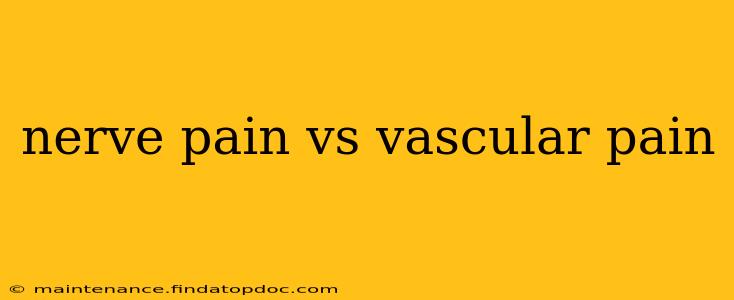Differentiating between nerve pain (neuropathic pain) and vascular pain can be challenging, as both can present with similar symptoms like aching, throbbing, or burning sensations. However, understanding their underlying causes and characteristics is crucial for accurate diagnosis and effective treatment. This article will delve into the key differences between nerve and vascular pain, helping you better understand the nature of your pain.
What is Nerve Pain (Neuropathic Pain)?
Nerve pain, also known as neuropathic pain, arises from damage or dysfunction within the nervous system itself. This damage can affect the nerves in various parts of the body, leading to a wide range of symptoms. The pain isn't simply a response to an injury; it's a malfunction in how the nervous system processes pain signals. This can result in chronic, persistent pain that is often difficult to manage.
Causes of Nerve Pain: Many conditions can cause nerve pain, including:
- Diabetic neuropathy: High blood sugar levels damage nerves over time.
- Shingles: A viral infection affecting nerve pathways.
- Multiple sclerosis (MS): Damage to the myelin sheath surrounding nerves.
- Carpal tunnel syndrome: Compression of the median nerve in the wrist.
- Sciatica: Compression or irritation of the sciatic nerve.
- Fibromyalgia: A chronic condition characterized by widespread musculoskeletal pain.
- Nerve injuries: Trauma, surgery, or other injuries can directly damage nerves.
Characteristics of Nerve Pain: Nerve pain is often described as:
- Burning: A searing, hot sensation.
- Shooting: Sudden, sharp, and stabbing pain.
- Tingling: A pins-and-needles sensation.
- Numbness: Loss of sensation.
- Hypersensitivity: Exaggerated response to touch or temperature.
What is Vascular Pain?
Vascular pain originates from problems within the blood vessels. It's often related to reduced blood flow, inflammation, or damage to the blood vessels themselves. This can cause pain in the affected area, often accompanied by other symptoms like swelling, discoloration, or changes in skin temperature.
Causes of Vascular Pain: Several conditions can lead to vascular pain:
- Peripheral artery disease (PAD): Narrowing of the arteries in the limbs, reducing blood flow.
- Raynaud's phenomenon: Spasms in blood vessels of the fingers and toes, reducing blood flow.
- Deep vein thrombosis (DVT): A blood clot in a deep vein, often in the leg.
- Inflammation of blood vessels: Conditions like vasculitis can cause pain and inflammation.
- Aneurysms: Bulges in the weakened walls of blood vessels.
Characteristics of Vascular Pain: Vascular pain might be characterized as:
- Aching: A dull, persistent pain.
- Throbbing: A pulsating pain.
- Cramping: A tight, squeezing feeling.
- Pain worsened by exertion: Activity reduces blood flow, increasing pain.
- Pain relieved by rest: Rest allows blood flow to recover.
How to Tell the Difference: Nerve Pain vs. Vascular Pain
Distinguishing between nerve and vascular pain requires a comprehensive medical evaluation. However, some clues can help differentiate them:
- Location of pain: The location might provide hints, but isn't always definitive.
- Type of pain: Burning, shooting, tingling suggest nerve pain, while aching, throbbing, or cramping might point to vascular pain.
- Response to activity: Nerve pain might not directly relate to activity, whereas vascular pain often worsens with exertion and improves with rest.
- Associated symptoms: Numbness, tingling, and hypersensitivity suggest nerve involvement, while swelling, discoloration, and changes in skin temperature suggest vascular issues.
What if I think I have nerve or vascular pain?
It's crucial to consult a doctor for a proper diagnosis. They will perform a physical examination, review your medical history, and may order tests like blood work, nerve conduction studies, or imaging scans (e.g., ultrasound, MRI) to pinpoint the cause of your pain. Accurate diagnosis is crucial for effective treatment, which can vary depending on the underlying condition.
Can nerve and vascular pain occur together?
Yes, it's possible to experience both nerve and vascular pain simultaneously, especially in conditions like diabetes where both nerve and vascular damage can occur. A doctor can help determine if both types of pain are present and tailor treatment accordingly.
What are the treatment options for nerve and vascular pain?
Treatment options vary greatly depending on the underlying cause and type of pain. They can range from medications (e.g., pain relievers, antidepressants, anticonvulsants for nerve pain; blood thinners, vasodilators for vascular pain) to physical therapy, lifestyle modifications (e.g., exercise, diet changes), and in some cases, surgery.
This information is for general knowledge and should not be considered medical advice. Always consult a healthcare professional for diagnosis and treatment of any pain condition.
